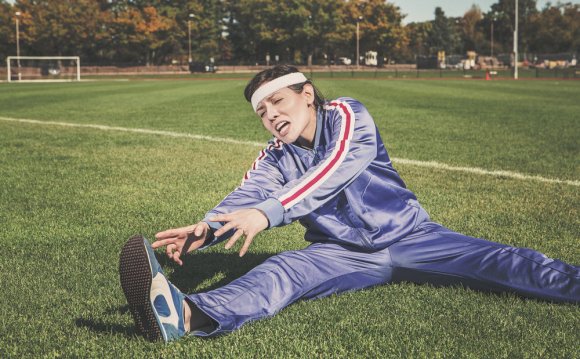
 Most yoga practitioners are acutely aware of their hamstrings. The hamstrings are a set of long muscles that descend along the backs of the legs, running from the hips to the knees. When the hamstrings contract, they extend the hip joint and move the thighbone backwards (think of what the legs do when jogging). They also work to flex and bend the knee. The hamstrings are often a limiting factor in our yoga practice, meaning that they are so tight that it’s hard to get into postures that depend on them, diminishing flexibility. Thankfully there are ways to stretch the hamstrings to allow our yoga practice to flow more freely.
Most yoga practitioners are acutely aware of their hamstrings. The hamstrings are a set of long muscles that descend along the backs of the legs, running from the hips to the knees. When the hamstrings contract, they extend the hip joint and move the thighbone backwards (think of what the legs do when jogging). They also work to flex and bend the knee. The hamstrings are often a limiting factor in our yoga practice, meaning that they are so tight that it’s hard to get into postures that depend on them, diminishing flexibility. Thankfully there are ways to stretch the hamstrings to allow our yoga practice to flow more freely.
One of the most troublesome postures to do with tight hamstrings is a standing forward fold (uttanasana). To allow yourself to fold forward more deeply, first come into cat/cow pose and flex and arch the spine. Feel how the pelvis tilts up and down with the movement of the spine. (Note: if you have trouble moving the pelvis in cat/cow, you may have problems in the hip joint or lower back rather than the hamstrings. In this case, it’s recommended that you consult a medical professional).
 Stop in cat pose, with the back of the rib cage moving toward the ceiling and the chin tucked into the chest, and notice how the pelvis is tilted and the lower back is lengthened. Now bring yourself up to standing and fold forward. Try to tilt the pelvis in the same way as in cat pose. Rotate the thighs toward each other to protect the lower back, then lengthen the spine and let gravity pull the torso downwards to gently stretch the hamstrings. Breathe long and deep, and slowly bring yourself back up to stand after several breaths.
Stop in cat pose, with the back of the rib cage moving toward the ceiling and the chin tucked into the chest, and notice how the pelvis is tilted and the lower back is lengthened. Now bring yourself up to standing and fold forward. Try to tilt the pelvis in the same way as in cat pose. Rotate the thighs toward each other to protect the lower back, then lengthen the spine and let gravity pull the torso downwards to gently stretch the hamstrings. Breathe long and deep, and slowly bring yourself back up to stand after several breaths.
There are many Kundalini Yoga kriyas for the hamstrings in a variety of different positions. Frogs are a great way to open them up, though you may need to modify this in the beginning. If your hands don’t reach the floor when you raise the buttocks and bring your head to your knees in your frog pose, place a block under the hands, so you always connect to something on the ground. For a short kriya that focuses on the hamstrings, including plenty of frogs, try “Keeping the Body Beautiful” from I am a Woman.

The hamstrings also get a good stretch when you do leg lifts while lying on the back. If your hamstrings are extremely tight, you may notice that when you raise the legs to ninety degrees (straight up), it’s hard to keep the legs straight. A trick that might help to better extend that leg is to engage the muscles in the OTHER leg, that is, the leg that is still on the floor. That will stabilize you on your mat and maybe give you a little more room to stretch upwards. One of my favorite Kundalini Yoga kriyas to address this is Adjusting the Centers of Interconnection and Intercommunication, in Reaching Me in Me. This kriya works progressively to lengthen the hamstrings, with the added benefit of engaging the abdominal muscles. While you work through this kriya, pay attention to what’s happening in the backs of the legs. After several weeks of continuous practice, you may see a loosening of the hamstrings.
The sciatic nerve, the longest nerve in the body, lies under one of the hamstring muscles in the back of the leg, and sometimes tightness in the hamstring can be felt in the sciatic nerve and vice versa. Sciatic nerve pain, or sciatica, is generally caused by problems in the lower back, and is more serious than tight hamstrings. Sitting for long periods of time or lifting heavy objects can result in sciatic nerve problems. Stretching the hamstrings can benefit the sciatic nerve. There is a Kriya for the Sciatic Nerve in Kundalini Yoga for Youth and Joy that is worth checking out, to keep the hamstrings limber and prevent sciatica.
If you have injured your hamstrings, or they are simply very tight, it’s important to be patient. The hamstrings can take a long time to heal. Pick a kriya that gently works on them, commit to a daily practice, and keep up. Apply ice, and if there is no progress, consult a medical professional. Eventually, even if slowly, your flexibility will increase.









